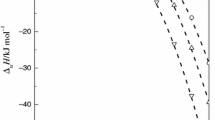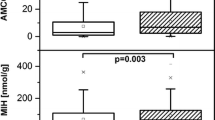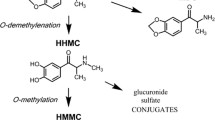Summary
In acute 2-h studies male and female rats were exposed to N,N-dimethylformamide concentrations of 209, 87, and 104 ppm with or without anoral dose of ethanol (2.0 g ethanol/kg) prior to inhalation.
In a subacute study (2 h/day on 5 consecutive days) with or without an oral administration of ethanol (2.0 g ethanol/kg) before starting the test, the N,N-dimethylformamide concentration was approx. 200 ppm.
Acute inhalation studies were performed on male dogs with N,N-dimethylformamide concentrations of 210–240 ppm and oral dose of ethanol (2.0 g ethanol/kg) immediately after or before the exposure.
In addition, 4 persons were exposed to N,N-dimethylformamide concentrations of 50–80 ppm for 2 h, with or without preceding oral ethanol administration (19 g ethanol/person).
The metabolic behavior of N,N-dimethylformamide and its metabolites (N-methylformamide, formamide) in blood and urine under the influence of ethanol was investigated.
Additionally, in the subacute study on rats as well as in the acute studies on persons, the ethanol and acetaldehyde concentration was also determined.
A delayed catabolisation of N,N-dimethylformamide was observed in the organism of rats and dogs after the oral administration of 2.0 g ethanol/kg prior to inhalation. This was confirmed by the elevated N,N-dimethylformamide concentration in the blood which decreased very slowly after exposure. After the administration of ethanol, N-methylformamide was not immediately detectable at the end of the inhalation period, but it was only found after a certain time lapse.
A small oral dose of 0.2 g ethanol/kg body weight on rats prior to inhalation, did not influence the metabolism of N,N-dimethylformamide.
During repeated exposure and daily pretreatment with ethanol, the metabolisation of N,N-dimethylformamide was also inhibited. However, the metabolisation of ethanol seemed also to be influenced by N,N-dimethylformamide.
After exposure and preceding administration of ethanol no increase of the N,N-dimethylformamide level in the blood of persons could be found. However, a comparatively lower N-methylformamide concentration in the blood damage of the membrane of the endoplasmic reticulum would be imaginable.
After acute ethanol intoxication Rubin et al. (1970) observed a decrease in the cytochrome P-450 activity in rats, which influences the electron transfer system and thus causes a dysfunction of the oxidation chain in the metabolism of foreign substances.
Cinti et al. (1973) reported on the interference of high ethanol concentrations with the binding of drug substrates to cytochrome P-450.
During repeated DMF exposure to rats, a slight inhibition of the ethanol oxidation was observed. This permits the supposition that it is only a question of concentration as to whether the inhibited metabolisation of the one substance is greater than that of the other.
Further experimental studies are planned to establish whether DMF or MF like some other amides (N-butyramide, isobutyramide; Lester, 1970) are able to inhibit ethanol- or acetaldehyde-dehydrogenase.
The occasionally observed intolerance reaction in employees exposed to DMF indicates an inhibition of the ethanol oxidation. However, in order to demonstrate this effect, significantly higher DMF exposures than we used in our study on persons are probably necessary. No influence can be expected on the metabolisation of ethanol in man at a DMF-exposure within the MAC range.
Similar content being viewed by others
Explore related subjects
Discover the latest articles and news from researchers in related subjects, suggested using machine learning.References
Barnes, J.R., Ranta, K.E.: The metabolism of dimethylformamide and dimethylacetamide. Toxicol. appl. Pharmacol. 23, 271 (1972)
Cinti, D.L., Grundin, R., Orrenius, S.: The effect of ethanol on drug oxidations in vitro and the significance of ethanol cytochrome P 450 interaction. Biochem. J. 134, 367 (1973)
Coldwell, B.B., Solomonraj, G., Trenholm, H.L., Wiberg, G.S.: The gas chromatographic estimation of ethanol, acetaldehyde, and acetone in ethanol metabolism studies. Clin. Toxicol. 4, 99 (1971)
Hausamen, T.-U., Helger, R., Rick, W., Gross, W.: Optimal conditions for the determination of serum alkaline phosphatase by a new kinetic method. Clin. chim. Acta 15, 241 (1967)
Kimmerle, G., Eben, A.: Metabolism studies of N,N-dimethylformamide. I. Studies in rats and dogs. Int.Arch.Arbeitsmed. 34, 109 (1975a)
Kimmerle, G., Eben, A.: Metabolism studies of N,N-dimethylformamide. II. Studies in persons. Int.Arch.Arbeitsmed. 34, 127 (1975b)
Lester, D., Benson, G.D.: Alcohol oxidation in rats inhibited by pyrazole, oximes, and amides. Science 169, 282 (1970)
Lieber, C.S.: Hepatic and metabolic effects of alcohol. Gastroenterclogia 65, 821 (1973)
Lieber, C.S., De Carli, L.M.: Hepatic microsomes: a new site for ethanol oxidation. J. clin. Invest. 47, 62 (1969)
Lieber, C.S., De Carli, L.M.: Hepatic microsomal ethanol-oxidizing system: In vitro characteristics and adaptive properties in vitro. J. biol. Chem. 245, 2505 (1970)
Liu, S.-J., Ramsey, R.K., Fallon, H.J.: Effects of ethanol on hepatic microsomal drug-metabolizing enzymes in the rat. Biochem. Pharmacol. 24, 369 (1975)
Misra, P.S., Lefevre, A., Ishii, H., Rubin, E., Lieber, C.S.: Increase of ethanol, meprobamate and pentobarbital metabolism after chronic ethanol administration in man and rat. Amer.J.Med. 51, 346 (1971)
Miller, G., Spassowski, M., Henschler, D.: Metabolism of trichloroethylene and ethanol III. Interaction of trichloroethylene and ethanol. Arch. Toxicol. 33, 173 (1975)
Popper, H., Mandel, E., Mayer, H.: Zur Kreatininbestimmung im Blut. Biochem. Z. 291, 354 (1937)
Potter, H.Ph.: Dimethylformamide-induced abdominal pain and liver injury. Arch. Environ. Hlth 27, 340 (1973)
Reinl, W., Urban, H.J.: Erkrankungen durch Dimethylformamid. Int.Arch. Gewerbehyg. 21, 333 (1965)
Reitman, St., Frankel, S.: A colorimetric method for the determination of serum glutamic oxalacetic and glutamic pyruvic transaminase. Amer.J.clin. Path. 28, 56 (1957)
Rubin, E., Gang, H., Misra, P.S., Lieber, C.S.: Inhibition of drug metabolism by acute ethanol intoxication. Amer.J.Med. 49, 801 (1970)
Schenkman, J.B., Frey, J., Remmer, H., Estabrook, R.W.: Sex differences in drug metabolism by rat liver microsomes. Mol.Pharmacol. 3, 516 (1967)
Schüppel, R.: Wirkungen von Alkohol auf den Arzneimittelstoffwechsel. In: Alkohol und Leber, S. 227–240. Stuttgart: Schattauer 1971
Schüppel, R., Petruch, F.: Zum Mechanismus der Kombinationswirkung von Barbituraten mit Athanol. Naunyn-Schmiedeberg's Arch. exp. Path. Pharmak. 257, 221 (1967)
Stewart, R.D., Hake, C.L., Peterson, J.E.: “Degreaser's flush”: Dermal response to trichloroethanol and ethanol. Toxicol. appl. Pharmacol. 29, 83 (1974)
Tolot, F., Droin, M., Genevois, M.: Intoxication par la dimethylformamide. Arch.malad.profess. 19, 602 (1958)
Author information
Authors and Affiliations
Rights and permissions
About this article
Cite this article
Eben, A., Kimmerle, G. Metabolism studies of N, N-Dimethylformamide. Int. Arch Occup Environ Heath 36, 243–265 (1976). https://doi.org/10.1007/BF00409355
Received:
Accepted:
Issue Date:
DOI: https://doi.org/10.1007/BF00409355




